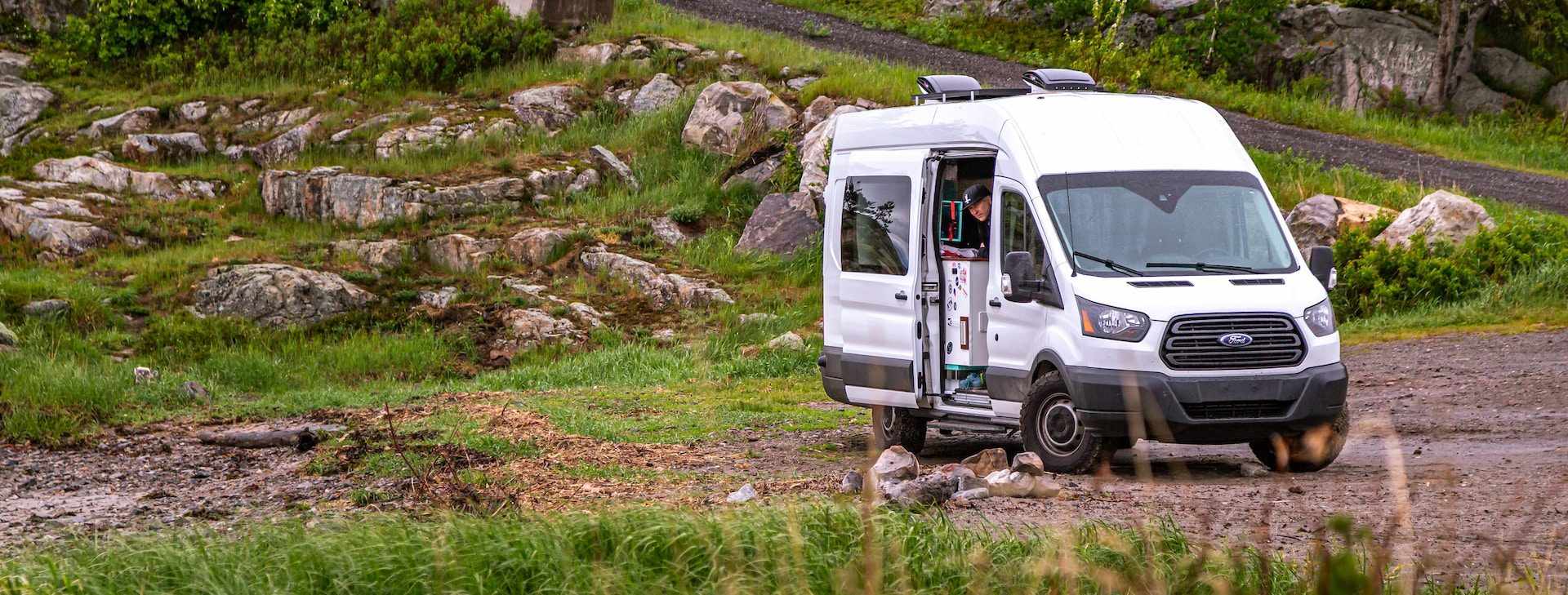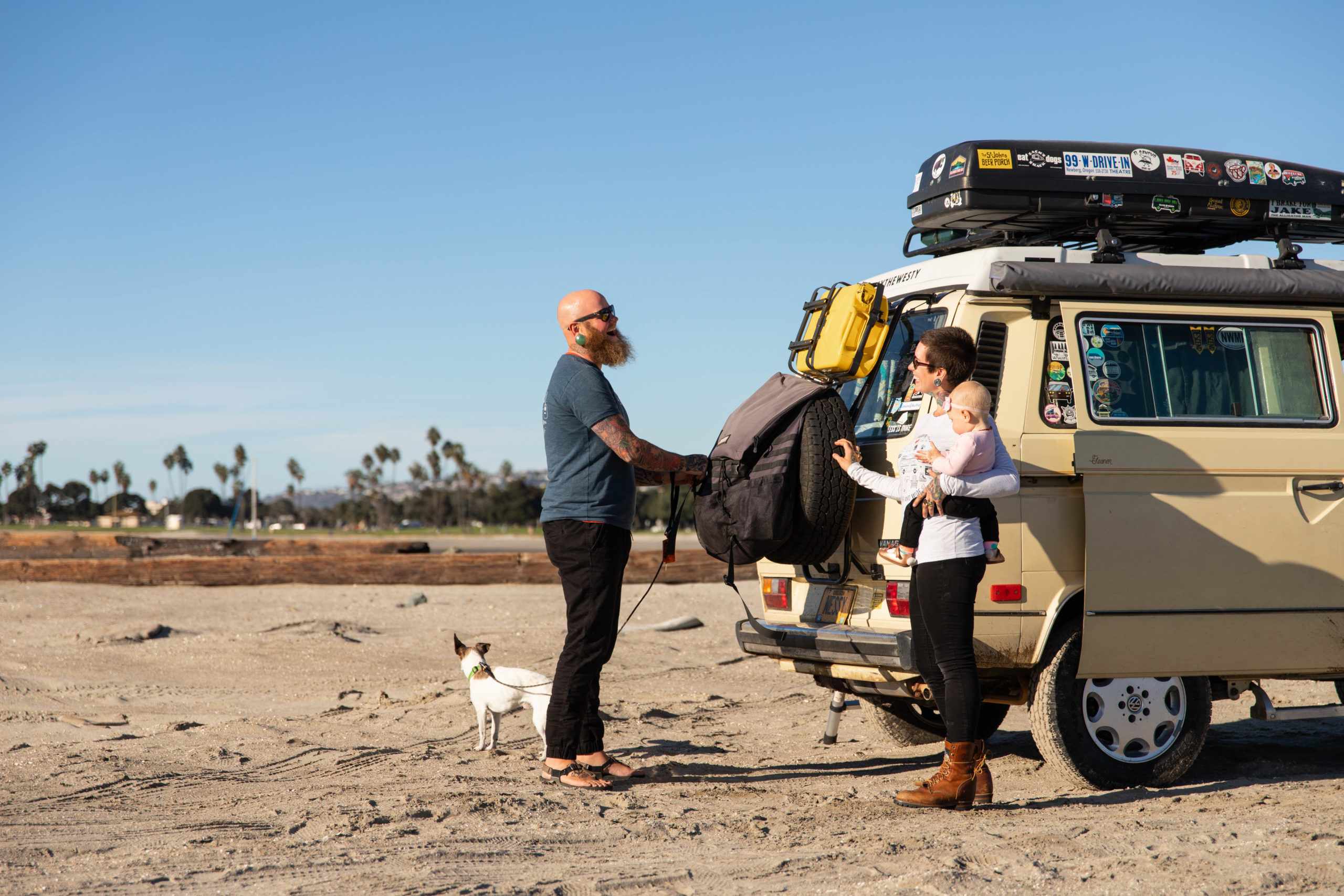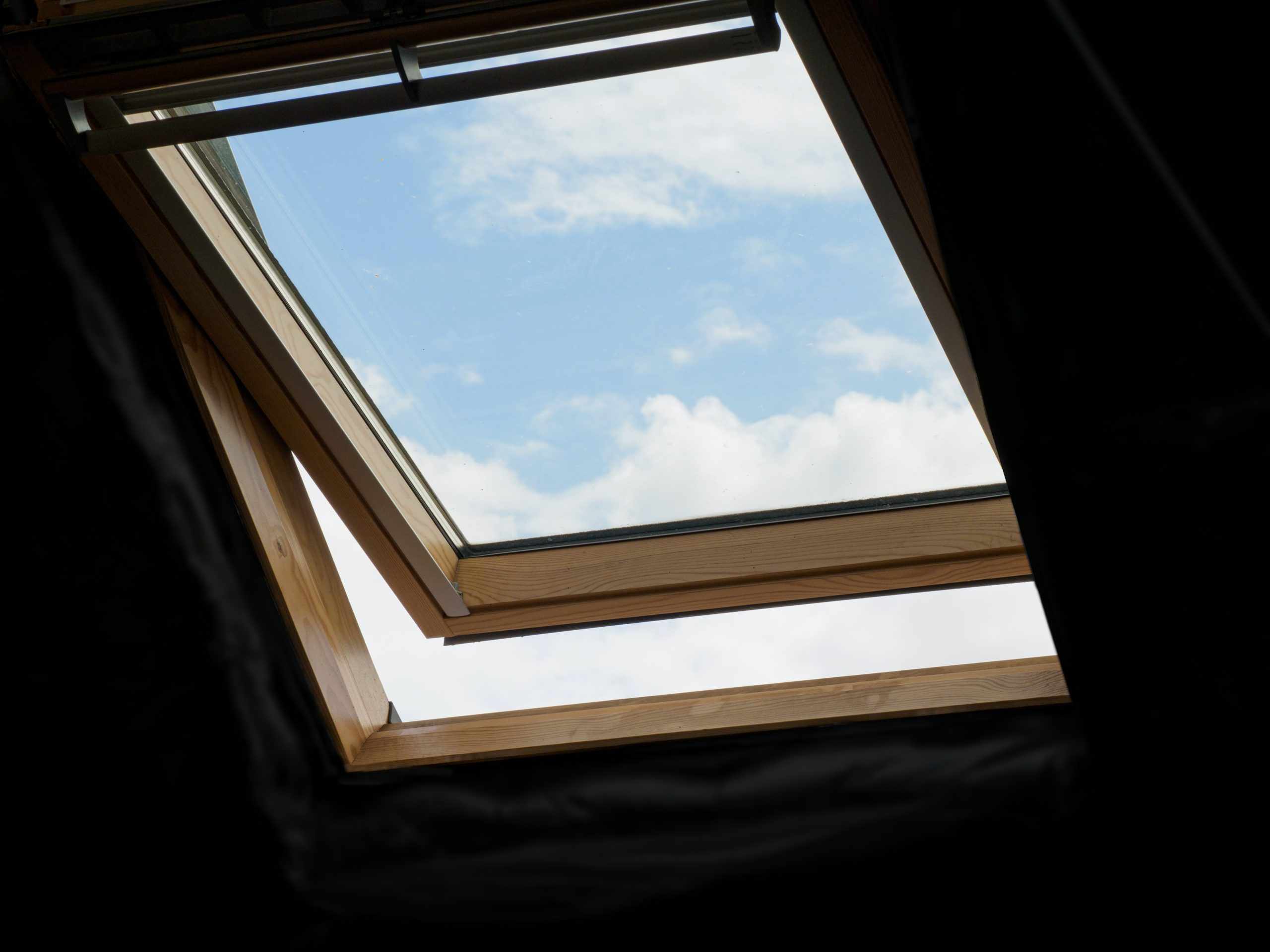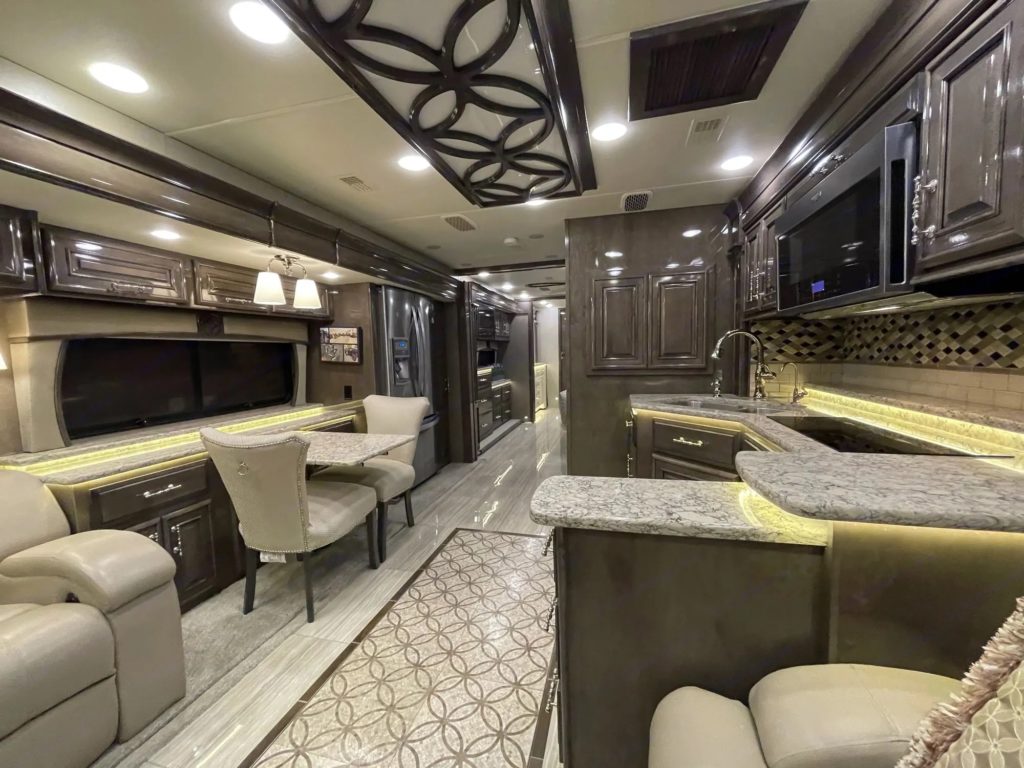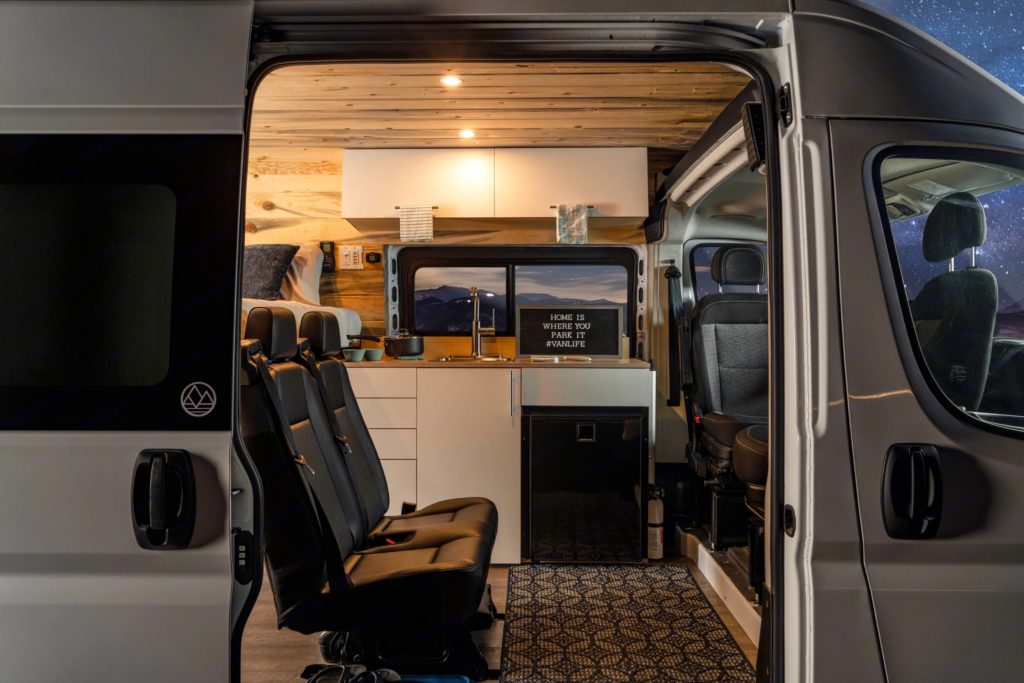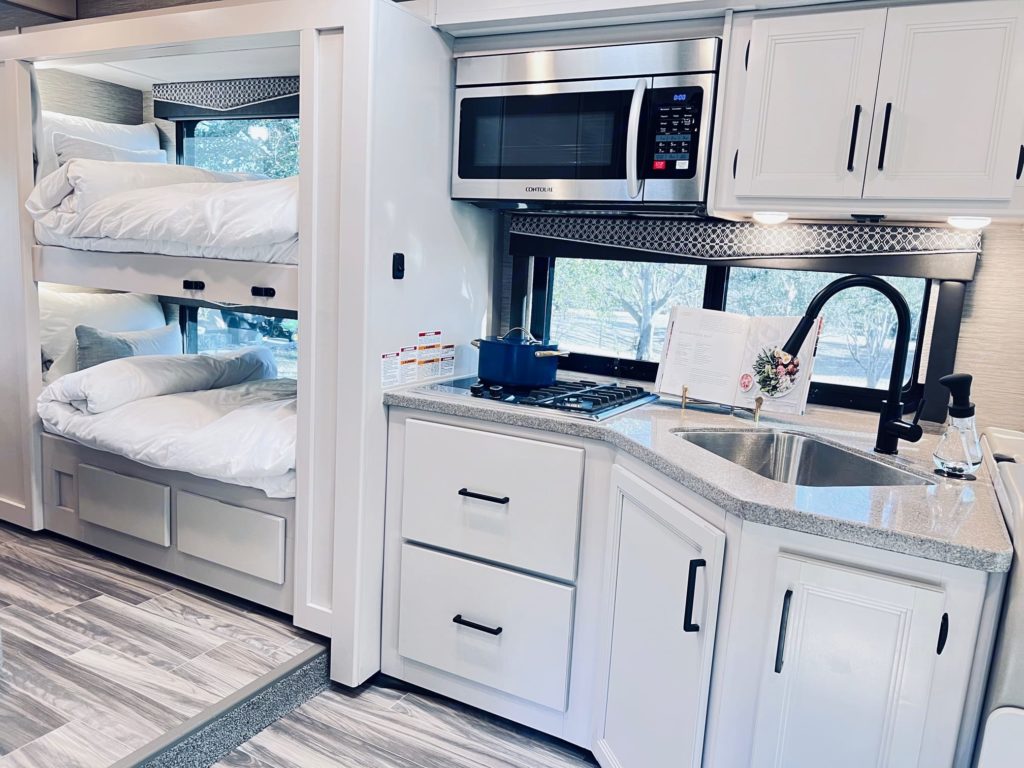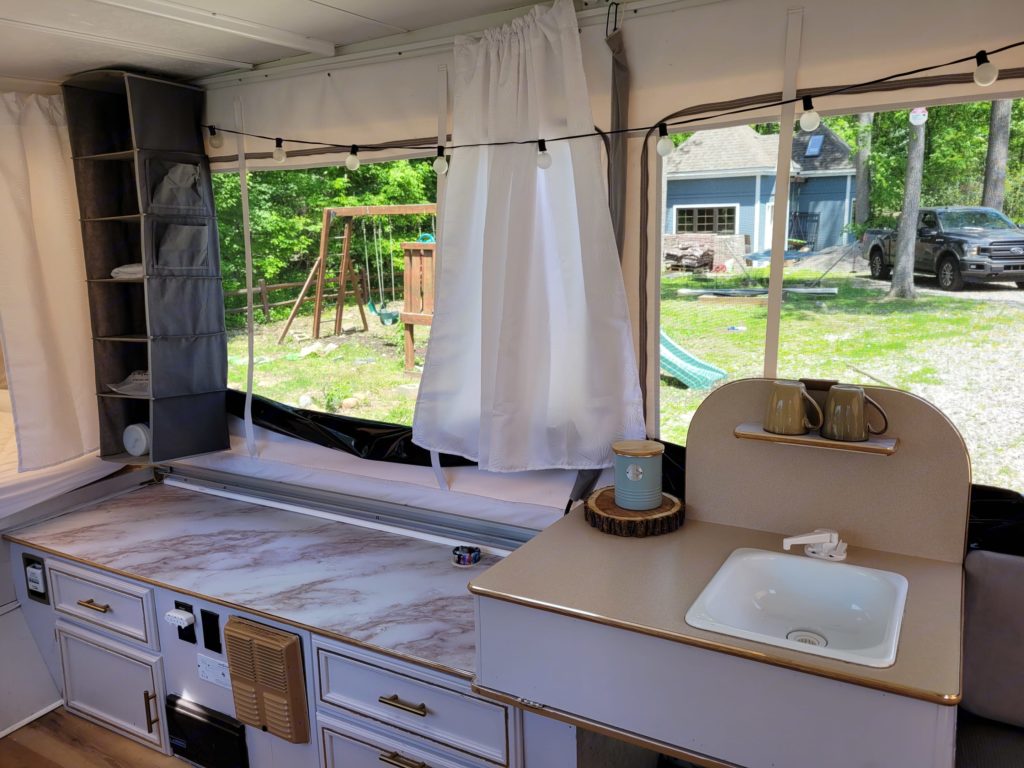One of the biggest benefits of taking your RV on the road: you can cook along the way! Cooking in your rig saves money and allows you to skip fast food and opt for healthy meals throughout your journey.
Saving money and eating healthy are both incredible benefits. We get a lot of questions from our renters about what to expect from their RV kitchen. Because so many people were asking about kitchens, we created this guide to walk you through what to expect out of an RV kitchen.
RVs For Rent Near You
Class A Kitchens
Because Class A motorhomes are some of the biggest RVs on the market, Class A coaches boast some of the biggest and most well-equipped kitchens in the RV world.
If you are looking to make yourself at home in one of these big motorhomes, you can expect to have nearly all of the wonderful amenities you might find in a house like a residential-sized refrigerator, a stovetop, a microwave, and sometimes a convection oven.
The few things you might not find include sprawling countertops and a dishwasher (although some newer luxury rigs have dishwashers now). Still, the counter space is nearly always sufficient, and hand-washing dishes isn’t really all that bad.
Class B Kitchens
Class B motorhomes are small. There is just no getting around that fact, and while RV designers are pretty clever with their space-saving tricks, Class Bs have a little less to flaunt in the kitchen department.
Still, almost all Class Bs include everything you need to cook a meal — only in a miniature size. This usually means an RV stove with two burners instead of three, a tiny refrigerator, and a single-basin sink instead of the usual double-basin.
One thing that is generally missing from a Class B kitchen is an RV oven. Therefore, baking shouldn’t be on your to-do list if a Class B is how you roll.
Class C Kitchens
Though smaller than the kitchens found in the enormous Class A rigs, Class C motorhomes tend to have pretty decent kitchen setups.
Most Class Cs include an oven and stove, full-sized sink, full-size RV refrigerator, and a microwave or a convection oven-microwave combo.
That said, some of the smaller models may skip the oven and go for a smaller RV sink and refrigerator in order to save space. If these things are important to you, be sure to look into the kitchen’s details before committing to anything.
Fifth-Wheel Kitchens
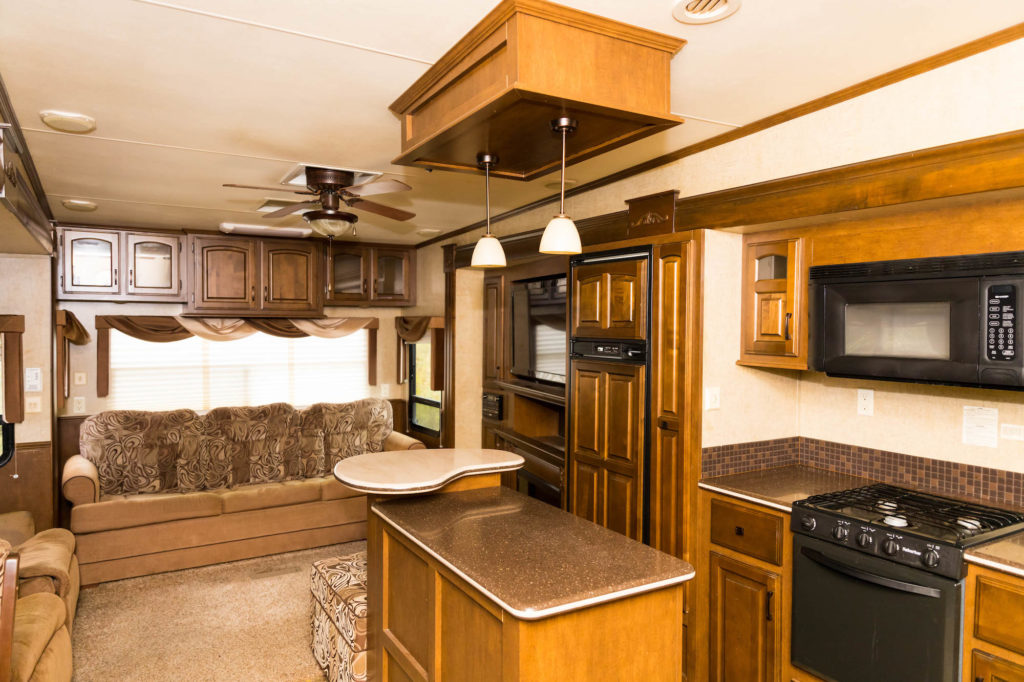
Fifth wheels tend to have the most living space out of all rigs. Therefore, the RV kitchens in these bad boys tend to have the most space to work with.
Almost every fifth wheel out there will include full-size versions of all the typical appliances. Still, rarely will you find one with a dishwasher.
Counter space can be improved upon in these larger living spaces though, so if counter space is a must-have, a fifth wheel might be your best bet.
Travel Trailer (Bumper-Pull) Kitchens
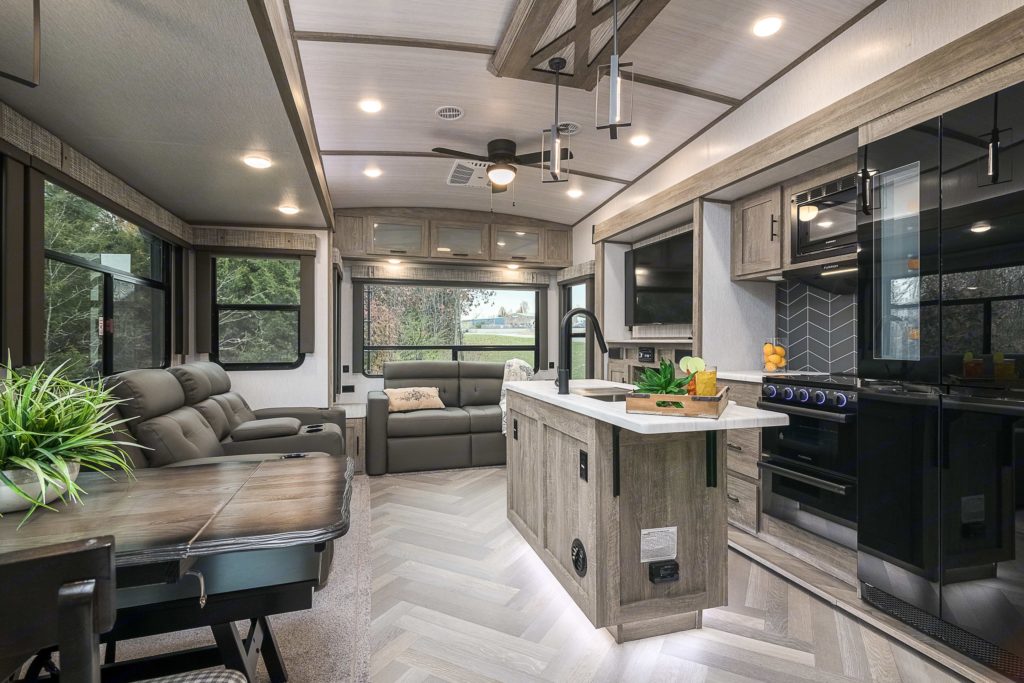
Travel trailers can vary greatly in the size department. Because of this, the kitchens can also come in a variety of sizes. A bumper-pull kitchen may be as roomy and well-equipped as one found in a fifth-wheel, or it could be more comparable to a Class B cooking setup.
In general, the bigger the bumper pull, the better the setup, so that is something to keep in mind while shopping around.
Pop-Up and A-Frame Kitchens
Pop-up and A-frame trailers have kitchens with shorter countertops and smaller fridges. They also tend to have a smaller amount of space to work with, which equates to a smaller kitchen in general. This means less counter space, a smaller RV cooktop, and a smaller sink.
Additionally, most of these rigs lack an oven, and many do not have a microwave either. This makes pop-up and A-frame trailers some of the least equipped when it comes to cooking.
Nevertheless, these types of trailers are ideal for a number of situations, making the smaller kitchens and fewer appliances a worthwhile tradeoff.
Teardrop Trailers
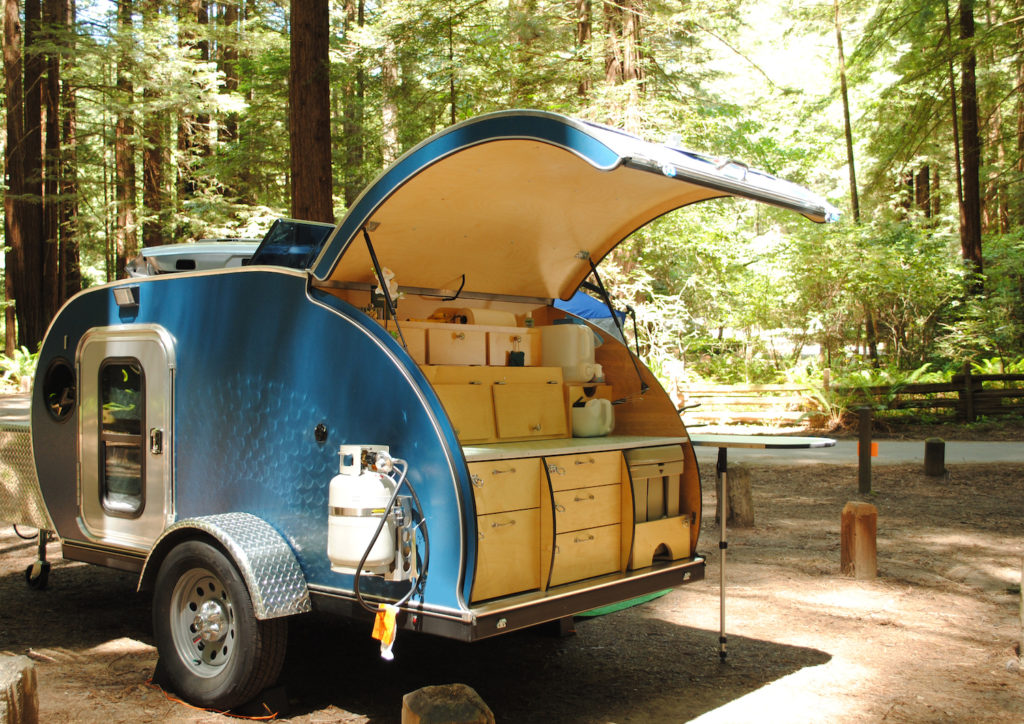
We all know teardrop trailers are tiny. Honestly, that’s what makes them so great.
However, it also makes them unsuitable for housing a kitchen, no matter how small. For this reason, teardrops either lack a kitchen, or they’re equipped with a small outdoor galley or tiny-inside kitchen.
Those with outdoor galleys may include a small sink, a small RV stove, a tank for water, and a place for food storage.
Outdoor Kitchens
Some rigs are so prepared to meet your cooking needs that they offer both an indoor and an outdoor kitchen.
Outdoor RV kitchens are great for those warm weather days when you’d rather be enjoying the great outdoors than being stuck inside. They also work well for preparing sides while grilling out.
Most outdoor kitchens or galleys include a cooktop and sink along with a bit of counter space for preparation.
What to expect from RV kitchen appliances and equipment
Now that you have a better understanding of the various types of RV kitchens out there, let’s talk about what is included in those kitchens.
For the most part, you will find that RV appliances are quite similar to what you are used to using at home. However, there are some differences you may want to be aware of.
Ovens
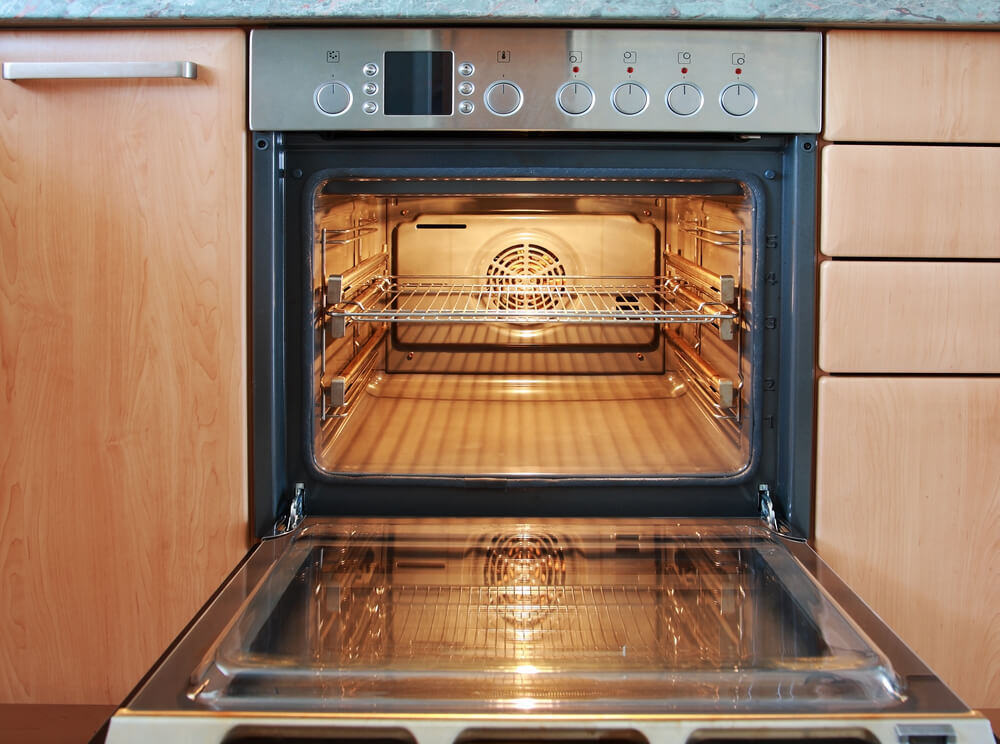
Not all RVs include an oven. However, some do, and unfortunately, many go unused because travelers have a hard time getting them started.
Here are a few tips:
- All RV ovens use propane in order to cook food in the same way a gas oven might cook food in a house
- Many RV ovens require you to relight them manually each time they’re used. It’s not a difficult thing to do, but if you’re unaware, you might have a hard time baking cookies
- There’s a tendency for an RV oven to cook unevenly, leaving chefs everywhere with baked goods that are burned in the middle. To solve this problem, simply place a pizza stone on the oven rack under whatever you are cooking. The stone helps distribute heat and gives that perfect, even-bake that everyone loves
Which RV ovens are best?
- Furrion gas range oven — Considering the amount of experience Furrion has with manufacturing RV appliances and products, it comes as no surprise that they are one of the top-rated RV ovens on the market.
- Suburban gas range oven — Suburban ranges are included in many trailers and motorhomes. They also receive excellent reviews and would be a good choice for any traveling baker
Stoves
RV stoves are also (propane) gas-powered. They are fairly self-explanatory for anyone who has ever used a gas stove. Those who haven’t may want to look at the manual first.
The thing that is a bit odd about RV stovetops is the number of burners. While most household stoves offer four burners to choose from, most RV stoves boast only two or three burners. While this doesn’t usually pose a problem, it might require extra planning on the part of the chef of the house.
Microwaves
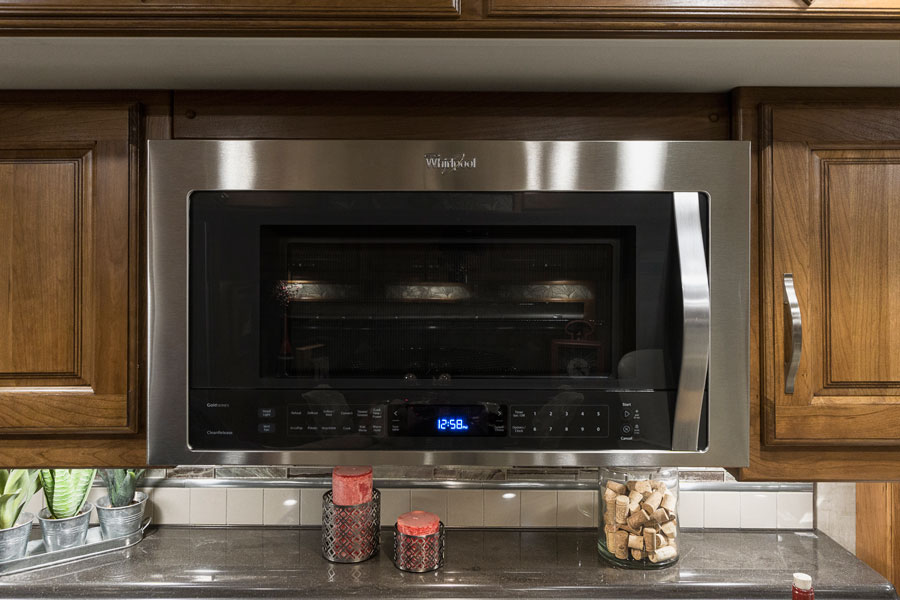
RV microwaves work in exactly the same way as any other microwave. There is one small thing you will want to be aware of when you do choose to use yours, though. Because most RVs are only able to pull a limited 30 or 50 amps of power at any given time, it can be easy to trip a breaker.
This is especially true when one is using a number of items that pull a lot of power. These include the air conditioner, hairdryers, toasters, coffee makers, and microwaves.
Running any one of these devices alone should not be a problem, but be aware that running the microwave while someone else is drying their hair may not work out so well.
There are a great many brands of microwaves that work well in RV kitchens.
What are the best RV microwaves?
- Toshiba Microwave Oven — Because these microwaves are made for a broad spectrum of uses, they are the ideal solution for any tiny kitchen.
- GE 4 in 1 Microwave — GE joins the running with high-quality microwaves that just keep on going. In fact, many RVs come equipped with similar microwaves straight from the factory.
- Samsung Over-the-Range Microwave — Whether you are looking to put a microwave in a house or an RV, Sharp is a top-rated brand with excellent reviews. Many of the Sharp microwaves placed in RVs are microwave and convection oven hybrids.
RV Refrigerators
RV refrigerators are interesting in that they run quite differently from the fridges we are used to using at home. While this won’t be noticeable for the most part, there are a few things that it could affect.
- When you first turn your refrigerator on, it is important to keep something like a few water bottles inside. This helps the fridge cool down faster
- It’s important to be aware of the fact that RV refrigerators can take up to 48 hours to become completely cold
- RV refrigerators need to be level to run properly, so make sure you level your rig to keep your fridge running the way it should
- Most RV refrigerators can run off of electricity or gas. While you are parked and hooked to shore power, it’s a good idea to use the electric option and save propane
- If you are boondocking in a place without hookups, the propane option works equally as well. Just keep in mind that the refrigerator will require a small amount of power at all times in order to run in gas mode. Therefore, if your battery goes dead during a boondocking trip, your food is not going to stay fresh for long
- To change the mode of your refrigerator, look for the small control panel on the face of the fridge. This should include two or more options, including gas, electric, and auto mode, the latter of which will run electric until shore power is no longer available, at which point it will switch to gas
There are two major brands of RV refrigerators out there. These are the very best options and should always be the go-to when an RV fridge needs to be replaced or upgraded.
RV Sinks

The taps in RV sinks are pretty great in that most can either pull water directly from your fresh water tank using a pump or allow water in from the outside tap. This makes for a versatile experience and allows for camping with or without hookups.
Of course, the water in a freshwater tank is limited, making it important to ration water during stints without water hookups. Nevertheless, pulling from a tank is an excellent option to have.
If you are unsure how to switch your pump on, check your user manual.
- Most pump switches can be found on a small control panel somewhere on the wall near the kitchen sink
- Flipping the switch will turn your pump on and allow you to pump water from your tank
- Just don’t run the pump without water onboard, or the pump can become damaged
Optimizing Your RV Kitchen Space
Maximizing space and efficiency in your RV kitchen is essential for a comfortable cooking experience. Here are some tips to help you make the most of your limited space:
- Utilize Vertical Storage: Install shelves or hanging organizers to keep frequently used items within reach and free up counter space.
- Choose Multi-Functional Appliances: Opt for appliances that serve multiple purposes, such as a convection microwave oven, to save space and increase functionality.
- Collapsible and Nesting Cookware: Invest in collapsible bowls and nesting pots and pans to save storage space when not in use.
- Magnetic Strips and Hooks: Use magnetic strips for knives and metal utensils, and hooks for hanging mugs or towels, to keep surfaces clear.
Essential RV Kitchen Appliances
Equipping your RV kitchen with the right appliances can enhance your cooking experience on the road. Consider the following essentials:
- Portable Induction Cooktop: Provides efficient cooking and can be stored away when not in use.
- Compact Toaster Oven: Offers baking capabilities without the need for a full-sized oven.
- Electric Griddle: Ideal for making breakfasts and can double as extra cooking space.
- Slow Cooker or Instant Pot: Allows for easy, one-pot meals with minimal supervision.
Maintaining Cleanliness in Your RV Kitchen
Keeping your RV kitchen clean is crucial for hygiene and functionality. Here are some tips to maintain cleanliness:
- Use Splatter Guards: Prevent grease and food splatters on surfaces to reduce cleaning time.
- Quick Clean-Up Routine: Develop a habit of cleaning as you cook to avoid a large mess afterward.
- Proper Ventilation: Use exhaust fans or open windows to reduce moisture and odors during cooking.
RV Countertops
As mentioned before, counter space isn’t exactly easy to come by in an RV. While this is understandable — given the smaller living space you’re working with — it doesn’t make it any easier to cook when you need that prep space.
If you are having trouble dealing with the lack of counter space, consider giving yourself extra room by:
- using the table as a cooking space
- pulling out a drawer and adding a cutting board on top of it
- placing a cutting board across the sink
- going outside to prep
FAQs about RV Kitchens
Q: Can I install a dishwasher in my RV kitchen?
A: While most RVs do not come with a built-in dishwasher, some larger models, like certain fifth wheels, may have the space and plumbing to accommodate one. However, installing a dishwasher can be complex and may require professional assistance.
Q: How can I increase counter space in my RV kitchen?
A: Consider using sink covers or stovetop covers that double as cutting boards to extend your workspace. Additionally, portable kitchen islands or foldable tables can provide extra surface area when needed.
Q: What type of refrigerator is best for an RV?
A: The choice of refrigerator depends on your needs and the size of your RV. Absorption refrigerators, which can run on propane or electricity, are common in RVs. However, residential-style refrigerators are becoming more popular due to their efficiency and larger capacity, though they require a consistent power source.
Q: Is it safe to use a propane stove inside my RV?
A: Yes, it is safe to use a propane stove inside your RV, provided it is properly maintained, and you follow safety guidelines. Ensure adequate ventilation while cooking, regularly check for gas leaks, and have a functioning carbon monoxide detector installed.
Q: How can I conserve water while washing dishes in my RV?
A: To conserve water, use a basin to wash dishes instead of running water continuously. Scrape off food scraps before washing, use minimal soap, and rinse all dishes together using a spray bottle or low-flow faucet.
As you can tell, there is a whole world to RV kitchens. However, now that you have read this guide, you should be well-equipped with the knowledge you need to cook some stellar meals on your next RV adventure.
By implementing these tips and understanding the features of your RV kitchen, you can create a more efficient and enjoyable cooking environment on the road.
